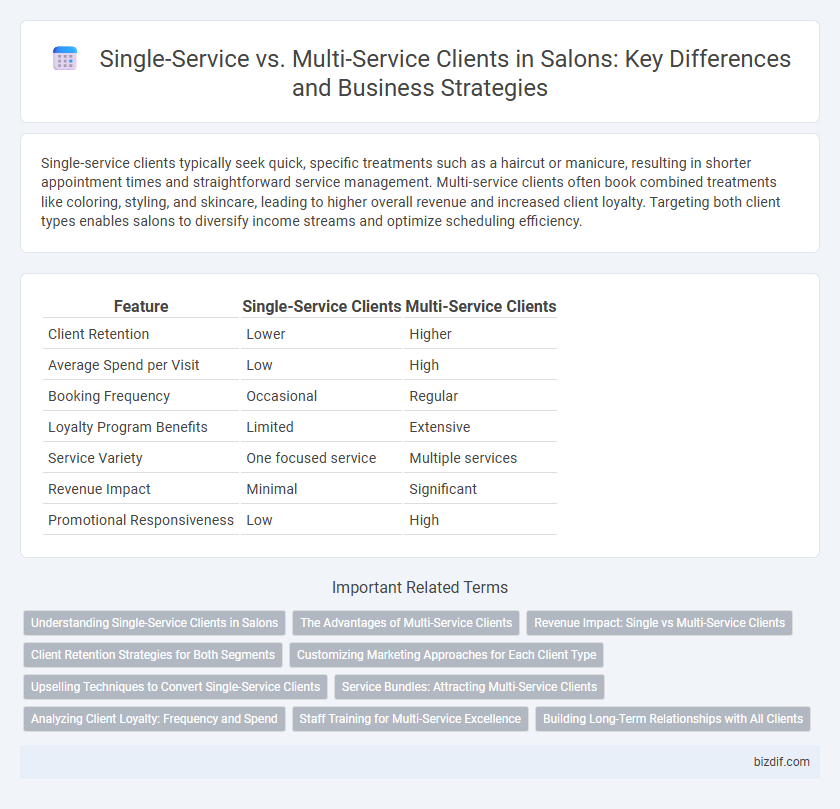Single-service clients typically seek quick, specific treatments such as a haircut or manicure, resulting in shorter appointment times and straightforward service management. Multi-service clients often book combined treatments like coloring, styling, and skincare, leading to higher overall revenue and increased client loyalty. Targeting both client types enables salons to diversify income streams and optimize scheduling efficiency.
Table of Comparison
| Feature | Single-Service Clients | Multi-Service Clients |
|---|---|---|
| Client Retention | Lower | Higher |
| Average Spend per Visit | Low | High |
| Booking Frequency | Occasional | Regular |
| Loyalty Program Benefits | Limited | Extensive |
| Service Variety | One focused service | Multiple services |
| Revenue Impact | Minimal | Significant |
| Promotional Responsiveness | Low | High |
Understanding Single-Service Clients in Salons
Single-service clients in salons typically seek specific treatments like haircuts or manicures, prioritizing quick and specialized service. These clients often value convenience and consistency, returning primarily for the expertise related to their chosen service. Understanding their preferences allows salons to tailor marketing strategies and enhance client retention by focusing on specialized service excellence.
The Advantages of Multi-Service Clients
Multi-service clients bring increased revenue and higher customer lifetime value to salons by booking various treatments such as haircuts, coloring, and spa services in a single visit. These clients often exhibit greater loyalty and engagement, enabling salons to create personalized experiences that enhance satisfaction and encourage repeat business. Offering bundled packages and cross-promotions to multi-service clients streamlines operations and maximizes the efficiency of staff and resources.
Revenue Impact: Single vs Multi-Service Clients
Multi-service clients generate 40% higher revenue per visit compared to single-service clients due to increased service utilization and product sales. Salons report that multi-service clients have a 30% higher retention rate, thereby boosting lifetime customer value and overall profitability. Focusing marketing efforts on promoting bundled services can significantly enhance revenue streams and client satisfaction.
Client Retention Strategies for Both Segments
Single-service clients often seek convenience and affordability, so targeted retention strategies include personalized discounts and loyalty programs tailored to frequently used services. Multi-service clients value comprehensive care, making bundled service packages and exclusive membership perks effective for enhancing long-term engagement. Both segments benefit from consistent communication, appointment reminders, and client feedback integration to improve satisfaction and retention rates.
Customizing Marketing Approaches for Each Client Type
Single-service clients often seek convenience and targeted offers, making personalized promotions and timely reminders effective for retaining their loyalty. Multi-service clients value comprehensive experiences and exclusive package deals that enhance their salon visits through tailored recommendations and bundled discounts. Customizing marketing strategies based on these client types increases engagement, boosts customer satisfaction, and maximizes revenue per visit.
Upselling Techniques to Convert Single-Service Clients
Upselling techniques in salons target single-service clients by suggesting complementary treatments that enhance their initial choice, such as recommending a deep conditioning treatment alongside a haircut. Personalized product recommendations based on client preferences and hair type increase client satisfaction and encourage multi-service bookings. Training staff to highlight benefits and package deals during consultations significantly boosts the conversion rate from single-service to multi-service clients.
Service Bundles: Attracting Multi-Service Clients
Service bundles significantly increase client retention by offering attractive packages that combine haircuts, coloring, and treatments at discounted rates. Multi-service clients contribute to higher revenue per visit and enhanced scheduling efficiency, benefiting salon operations. Targeted promotions on service bundles drive cross-selling, encouraging single-service clients to try additional services and transition into multi-service patrons.
Analyzing Client Loyalty: Frequency and Spend
Multi-service clients typically demonstrate higher loyalty through increased visit frequency and greater overall spend compared to single-service clients. Analyzing booking patterns shows that multi-service clients return more regularly, contributing to steady revenue growth and enhanced client retention rates. Targeted marketing strategies focusing on upselling to single-service clients can effectively boost their spend and encourage loyalty.
Staff Training for Multi-Service Excellence
Training staff to excel in multi-service delivery enhances client satisfaction and increases revenue per visit. Skilled professionals capable of providing diverse treatments, from haircuts to skincare, create seamless experiences that encourage multi-service client retention. Investing in comprehensive training ensures service consistency, boosts client trust, and drives overall salon success.
Building Long-Term Relationships with All Clients
Focusing on building long-term relationships with both single-service and multi-service clients boosts client retention and overall salon revenue. Personalized experiences and consistent communication encourage single-service clients to explore additional services, converting them into multi-service clients. Multi-service clients demonstrate higher loyalty and lifetime value, making strategic engagement essential for sustained salon growth.
Single-Service Clients vs Multi-Service Clients Infographic

 bizdif.com
bizdif.com